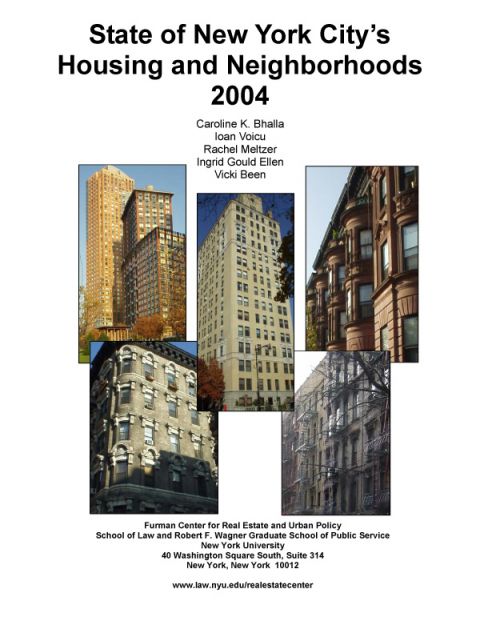State of New York City’s Housing & Neighborhoods – 2004 Report

Download the report
PDF, 18 MB
The State of New York City’s Housing and Neighborhoods 2004 provides an overview of housing and neighborhood conditions in the City and summarizes recent developments in policy, law, and research related to housing.
You can access our Focus Chapter and Citywide Data in the PDF files below. For a copy of the full report, email furmancenter@nyu.edu.
- Introductory material Includes the front cover, Acknowledgements, Preface, Table of Contents, List of Tables, List of Figures, and the Executive Summary.
- Part I: Major Changes and Proposed Changes in Laws, Regulations or Public Policies Affecting New York City Land Use and Housing New to the report this year, this section contains brief summaries of changes and proposed changes to laws and regulations affecting New York City land use and housing. This section covers laws enacted or regulations that became effective, as well as those proposed, between September 30, 2003 (the closing date of the 2003 State of the City’s Housing and Neighborhoods report) and December 31, 2004.
- Part II: A Look Back at the Year in Affordable Housing, 2003 During 2003, New York City’s housing developers, financial institutions and advocacy groups participated in a wide variety of projects designed to expand affordable housing options for low- and moderate-income New Yorkers. This section of the State of New York City’s Housing and Neighborhoods provides a brief overview of some of the activities and projects that took place during 2003.
- Part III: Recent Research Findings The third section summarizes recent published research on subjects related to housing and community development in New York City. Topics include homelessness and housing stability; housing attainment, choice, and quality; community development and gentrification; and housing policy and regulation.
- Chapter I: Housing Stock Provides information on the number of housing units, homeownership rates, forms of ownership, rental vacancies, and rent regulation.
- Chapter II: Housing Creation Covers new units issued certificates of occupancy and the rehabilitation and construction of housing under New York City’s Capital Programs.
- Chapter III: Housing Values Presents data on monthly rents and exclusive price indices that describe the price fluctuations of 4 types of housing—condominiums, single family homes, 2-4 family homes, and 5+ unit apartment buildings.
- Chapter IV: Housing Affordability Provides a picture of lending activity for home purchases and home refinance in the City, including measures of subprime lending.
- Chapter V: Mortgage Lending Provides a picture of lending activity for home purchases and home refinance in the City, including measures of subprime lending.
- Chapter VI: Mortgage Foreclosures Presents data on the filing of notices of foreclosure actions (lis pendens) and title transfers subsequent to these filings.
- Chapter VII: Property Tax Delinquencies Provides data on the number of delinquent properties in tax class 1 and tax class 2, as well as delinquencies of 1 year or longer, the dollar value of tax liens, and tax lien sales.
- Chapter VIII: Housing Quality Presents indicators such as maintenance deficiencies, housing code complaints and violations, and severe crowding.
- Chapter IX: Land Use Presents population counts from the 2000 United States census as well as data on household size and length of tenure.
- Chapter X: Population Presents population counts from the 2000 United States census as well as data on household size and length of tenure.
- Chapter XI: Race and Ethnicity Presents race data from the 2000 census, as well as other information on Puerto Rican households.
- Chapter XII: Immigration Contains data on the foreign-born population, languages spoken at home, and linguistic isolation.
- Chapter XIII: Income, Public Assistance and Education Includes median incomes, poverty rates, public assistance rates, and adult educational attainment.
- Chapter XIV: Business and Employment Presents information on business establishments by sector, labor force participation, and unemployment rates.
- Chapter XV: Public Schools Contains data on teachers’ credentials and student performance.
- Chapter XVI: Crime Presents a snapshot of property- and violent crime rates throughout New York City.
- Part V: Affordable Housing Organizations in New York City This final section briefly describes the key organizations in New York City involved in community development, affordable housing, services for homeless families, and in policy and advocacy related to housing.
- Appendix Contains an explanation of the sources of data used throughout the report, and the methods used to transform the data into specific indicators.


